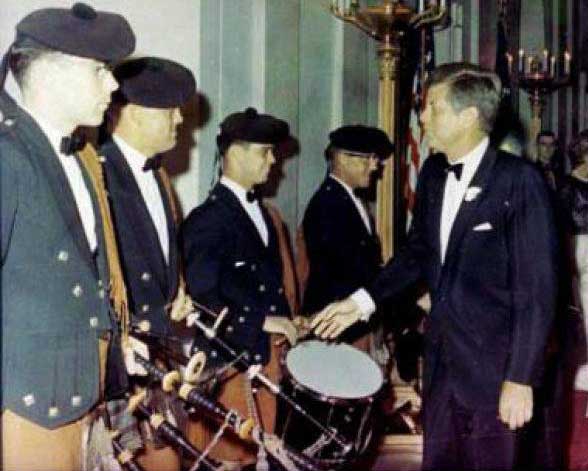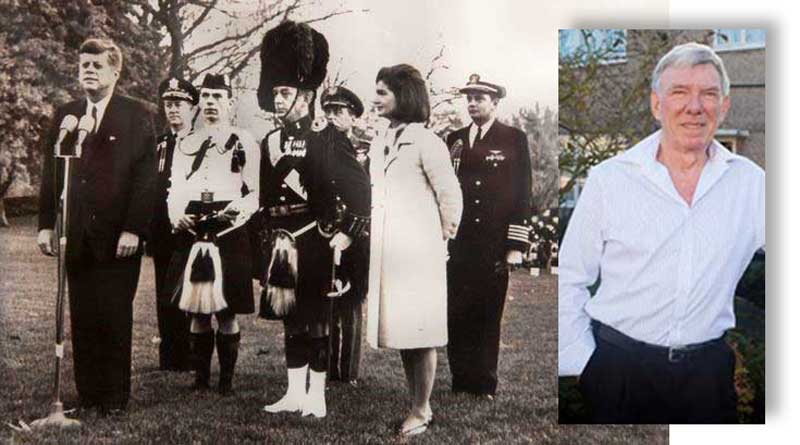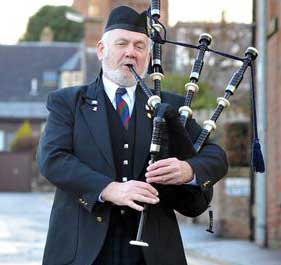The last happy days – the great highland bagpipe in JFK’s Camelot
“I am certain that after the dust of centuries has passed over our cities, we, too, will be remembered not for victories or defeats in battle or in politics, but for our contribution to the human spirit.” (JFK)

By Major Robert Keith Gunther
The assassination of United States of America President, John Fitzgerald Kennedy (JFK) invokes as much fascination as did his presidency, affectionately known as ‘Camelot’. JFK’s assassination and the days immediately following it are seared into our collective memory. An integral component of this was the presence of the great highland bagpipe during both the brightest and darkest days of his short but colourful presidency.
No one can actually pin down the exact reason why the instrument is so very closely associated with President Kennedy. Was it the ingrained memory of pipers at numerous state functions or of JFK being carried to his final resting place by the tune Mist Covered Mountains? Was it is due to complicated individual memories of JFK or by what journalist, David von Drehle calls, “the endless quest to recover the shattered promise of that man (which) reflects the unique relationship that many Americans had with their 35th President”? Was it a myriad of reasons: his Irish ancestry, his professed fondness for Scotland, the music itself, or the associated military precision of pipe band marching (JFK was a WWII veteran)?
JFK’s unique presidential legacy to piping is not only present in collective memory, but also in the U.S. military via the recently disbanded USAF Reserve Pipe Band and the US Army Special Forces (Green Berets), who unofficially use pipers at major ceremonies and events. JFK was a huge benefactor and the unofficial ‘Colonel in Chief’ of the Green Berets.
The goal of my article is to chronicle the presence of pipers and pipe bands during the vibrant days of JFK’s Camelot not just the dim days that culminated his tenure. It is important to detail this positive aspect of piping to the collective memory and to verify incorrect or misleading versions that now surround this collective memory. Washington Star music critic, Irving Lowen’s comment about the JFK funeral is extremely valid. He wrote: “Every momentous event breeds legends, and already the legends about the music that accompanied the dead march proliferate. Some are entirely wrong.” It is a common misperception that only one Pipe Band played during JFK’s state funeral when in fact two separate and distinct pipe bands actually received this honor. It is also a misperception that pipers symbolise the darkest day of his tenure when in fact they symbolise its brightest days.
The Kennedys and the arts
American historian, Lewis Mumford stated that President Kennedy was “the first American President to give art, literature, and music a place of dignity and honor in our (American) national life.” The Kennedys embraced art, music, literature, and culture to showcase American contributions to the world body. Mumford added:“… the first and last major entertainment to be held at the Kennedy White House featured the bagpipes, an instrument appealing to his Irish ancestry.”
Numerous official state visits at the White House or official visits abroad incorporated the great highland vagpipe. The USAF Pipe Band performed at the very first state dinner for President Habib Bourguiba of Tunisia on May 3, 1961. Mrs. Kennedy took a trip to Pakistan on March 24, 1962, where she listened to pipers from the Khyber Rifles. The USAF Pipe Band played for JFK at the Dulles Airport Dedication ceremony on November 17, 1962. Pipers Robert Fulton and George Lucas of the USAF Pipe Band danced in the East Room of the White House for a performance of the musical Brigadoon after the formal dinner given in honour of King Hassan II of Morocco’s state visit on March 27, 1963. A silent film of the performance can be seen here:
http://www.jfklibrary.org/Asset-Viewer/Archives/JFKPPP-45.aspx.
Piper Jerry Cashion also states that the USAF Pipers played at the annual Easter Egg Roll in 1963.
On September 5, 1963, the USAF Pipe Band and the USMC band played for the arrival of King Zahir and Queen Homaira of Afghanistan on the South Lawn of the White House. This event had “big plans for starting the fall [autumn] social season” in 1963. The event was planned initially to take place outdoors, but due to rain, the 116 guests were moved into the State Dining Room for the initial portion. After dinner, JFK and the King observed the United States Marine Corps (USMC) band and USAF pipers followed by fireworks from the second floor balcony of the White House. It was described as “a magnificent display”. A silent video of this event can be seen at http://www.jfklibrary.org/Asset-Viewer/Archives/USG-03-A.aspx

A USAF Pipe Band quartet performed at the official state visit of Prime Minister Lemass of Ireland in mid-October, 1963. Jerry Cushion commented that at this event JFK said, “Here come the ladies from Hell”. The JFK library has an audio recording of this state visit (no piping, however) as well. James Neary of the USAF Pipe Band was put on official military orders to go from Washington DC to New York city to borrow the kilts from the County Tyrone Pipe Band there in lieu of wearing “Irish costumes” that the White House Social secretary had acquired from a costume shop.
The most publicised piping event, as well as the last official state event of the JFK White House, was The Black Watch charity performance on the South Lawn on Wednesday, November 13, 1963. It was dubbed OPERATION WHITEHOUSE by the Black Watch Officer Commanding (OC) Tour. President Kennedy’s affinity for Scotland (and piping) is clearly evident in his opening remarks at this event It can be viewed at the following JFK Library link:
http://www.jfklibrary.org/Asset-Viewer/Archives/JFKWHF-WHN11.aspx.
First Lady Jackie Kennedy wrote after the event that, “I don’t know when I have seen the President enjoy himself more”.
Upon their arrival at Andrews Air Force Base in Washington, DC, the USAF Pipe Band greeted the Black Watch band on the day of the performance at 12:00. They had lunch and changed into their regimental attire for the event. The last plane didn’t arrive till 13:00 that day which shortened the timeline, to say the least, according to the Black Watch’s Red Hackle magazine. The article went on to state that the event came about when JFK told the United Kingdom ambassador, that he wished to be “serenaded by the Black Watch” thus the charity event came about. The Black Watch had a two-day period in which to accommodate the performance. November 14,1963 was an alternate day in case of in bad weather.

What is remarkable about the event is that President Kennedy opened up the White House to 1,700 local Washington DC area children as guests to this historical performance. If you look closely at the audience you will see how the children present were an integrated composite of America, something that was quite uncommon in the early 1960s in the segregated country. It was not just a charity performance on the South Lawn, but also a composite of JFK’s views on civil rights. The White House tasked 12 military buses to transport the underprivileged children to the event.
Kennedy opted not to invite the 400 children of members of Congress as it would have detracted from ticket sales of the Black Watch performance in Washington DC on November 19, 1963 as well as causing a traffic jam by the mothers who would have taken their children to the event. Nancy Tuckerman, the White House Social Secretary, had the President approve the use of 12 military buses to transport the children to the White House.
An interesting perspective of the event is from Michael Daly, whose Irish father, Chuck Daly, was a special assistant to President Kennedy. According to the article, ‘My Last Day with JFK’, Daly was selected as a White House junior host for the youngsters who attended the event and his main task of the day was, “little more than to point toward an enormous supply of cookies. They devoured in what had to be a world record”. Former Black Watch soldier, Dennis Byrne described another interesting moment. Byrne held the dirk that was presented to JFK as a gift from the regiment. In David Taylor’s article from the Daily Record newspaper, Byrne tells of the trouble they got into when the Black Watch soldiers came across a huge trampoline in the White House Gardens. He said “We were jumping up and down on this trampoline in full Highland dress – you can imagine the carry-on at that age”. Secret Service agent, Clint Hill was the one who told them off. He was the agent with the President in the limo in Dallas that dark day.
Mr. Daly wrote that the Black Watch filed out onto the South Lawn at 4:00pm and upon the President’s opening speech, “he seemed very much a chief and the spectators all rose unbidden”. Daly commented that he figured he would have ample opportunity to see Kennedy in the future. He did not imagine he would hear these pipers again. “To me, what was fixed was the President”, Douglas (Michael Daly’s brother, wrote. “The momentary was the bagpipes”.
At the conclusion of the performance, the Black Watch band was invited inside the White House for refreshments. The band was impressed with having sodas, whiskys and conversation with Mrs. Kennedy and other high level Kennedy administration members, something that would have been unheard of in the UK at the time. The Red Hackle magazine stated: “The President and Mrs. Kennedy were kindness itself, behaving in a most free and natural way, with the children running at their feet”.
As The Black Watch departed the White House grounds, JFK even boarded the band’s bus to pass on his personal thanks to the men who played that day. According to Piper Bruce Cowie, “We were leaving the White House on the bus and JFK came on with secretary of state Dean Rusk to thank us personally. It was a real personal touch.”
The Red Hackle magazine summarised it as “a gesture which was as kind as it was spontaneous, and will live long in our memories”. Cowie said JFK shook every piper’s hand and thanked them for their work — something that still resonates with him today.” In an interview, Cowie stated that this interaction “merely understates to me, the greatness of the man”. He went on to add that “Only the Queen Mother ever showed the same thoughtfulness to the ordinary rank and file”.
According to Martin Dalziel’s article ‘An Amazing Experience – Forfar Man remembers the day he met JFK’, multiple “Angus lads” also performed that day, to include the aforementioned Dennis Byrne, a bass drummer and highland dancer, Ronald Cairns, a piper, now living in Australia, and Bob Simpson, a drummer from Arbroath. In Dalziel’s article, Dennis Byrne is identified as playing “a key role for the group during the White House event by holding an officer’s dirk” for presentation to JFK.
After the South Lawn charity performance, The Black Watch continued with its ongoing three-month tour in the U.S.A. According to the Bolling Air Force Base Paper, the USAF Pipe Band had been guests of the President that day as spectators. Seamus Neary of the USAF Pipe Band remembers speaking with Lt-Col Duncan Beat, the tour’s musical director in a restaurant near their DC hotel. Neary stated: “He was not only a delightful person, but also a very fine musician”. Beat went on to become the Director of the Royal School of Military Music at Kneller Hall.
Immediately following the South Lawn Performance, Mrs. Kennedy sent a thank you letter to Major Wingate Gray on November 14, 1963. She wrote: “The precision, formation, and timing of your brigade leaves no margin for improvement, and I don’t know when I have seen the President enjoy himself more.” The First Lady also commented on how the Kennedy children, Caroline and John, interacted with Major Wingate Gray on the porch. She enclosed photos for each member of the band as a memento. As if The Black Watch performing on your lawn couldn’t be topped, the President was visited at the White House a few hours later by Greta Garbo. Perhaps this was just an ordinary day in Camelot?

On November 17, 1963, Drum Major/Piper James Neary of the USAF Pipe Band hosted a party at his place on Bolling Air Force Base, Washington, D.C. It included pipers and drummers from the both the USAF Pipe Band and The Black Watch. The Black Watch performed in DC on November 18, 1963. USAF Pipe Band members included: Sandy Jones, Jim Neary, John Bosworth, Alex Massie, John Ryan, and Jack McGilvary. Black Watch Pipers included Alec Menzies, Bobby O’Donnell, Drew Carstairs, Jimmy Hume, Dave Robertson, and Drummer Lenny Lang. Neary has an audio tape of the party featuring Black Watch pipers, Bobby O’Donnell and Dave Robertson singing traditional songs.
The State Funeral
According to Private First Class Arthur A. Carlson, who led the rider-less horse during the funeral, Prince Phillip commented that there was no need to hurry to get to the States to attend the funeral as “it would take at least two-weeks to plan and execute such a funeral”. This massive and ornate state funeral was executed significantly quicker than Prince Phillip’s best guess at the behest of those actually participating in it.

Thomas F. Reid, a 26-year-old Captain, the Company Commander of Delta Company, 3rd US Infantry, (The Old Guard) stated that “The Military District of Washington (MDW) had a master plan for conducting a State Funeral, but we never rehearsed the funeral of the incumbent president, so no specific plan had been formulated for him. We only had the basic master plan to work with as a template.”
As a result, the state funeral preparations were highly accelerated and chaotic with almost hourly changes to the plan, including the late breaking addition of two pipe bands into the ceremony. Captain Reid stated that when “the Air Force Bagpipe Band was given a role in the ceremony, I had to find a way to fit them into the sequence of events. At the last minute, I was told to expect the arrival of a nine-man detachment from the British Black Watch Regiment, and to fit them into the ceremony someplace.”
A key point to note is that varying memories exist of the state funeral, because no two participants in it had the same view. This must be taken into account when reading thru the multiple sources available. This is plausible explanation for the misleading collective memory of the time period.
The entire funeral plan is detailed in “the Last Salute: Civil and Military Funerals, 1921-1969.Chapter 23 covers the State Funeral of President Kennedy from 22-25 November 1963. The funeral order of march was from the U.S. Capital Building to the White House to St. Matthew’s Cathedral to Arlington National Cemetery.
The Black Watch
Bruce Cowie and the rest of The Black Watch band were approaching their hotel when news came through of the assassination. “It was surreal,” said Bruce. When news of the assassination filtered across the country the band’s evening performance was called off out of respect. The Black Watch tour modified its performances and tunes to accommodate the particular US state’s feelings in regards to the national state of mourning.
According to the Red Hackle magazine, immediately after the assassination, The Black Watch performed a small public tribute to JFK in Knoxville, Tennessee. The Pipe Major played Flowers of the Forest, followed by the American national anthem. The tribute was initiated with a short speech by the OC Tour, in which The Black Watch members were “offering our empathy to the American people and associating ourselves with them at this time”.
On 24 November 1963, the Pipe Major and eight pipers flew from Knoxville to Washington, DC and were met by Mr. R. C. Robertson of the British Army staff. The nine-man Black Watch contingent was invited to march in JFK’s funeral procession by Jackie Kennedy, who remembered how much JFK had enjoyed the South Lawn performance. Bruce Cowie confirmed that some of the pipers marched with cuts and bruises from a bar fight in Kentucky, defending JFK’s name on the evening of the assassination. He stated: “There were a few of the pipe band and also several of the military band that did get involved and a few did require hospital treatment.”
• Tomorrow, Robert discusses JFK’s funeral procession, the tunes played and the role played by the USAF Pipes & Drums.






